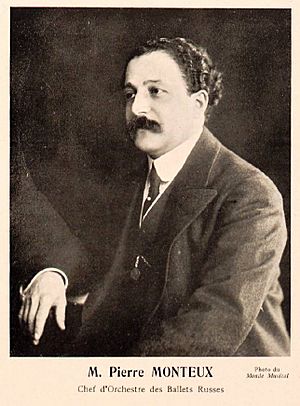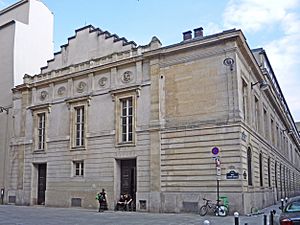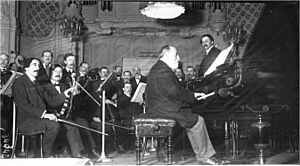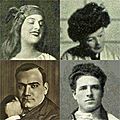Pierre Monteux facts for kids
Pierre Benjamin Monteux (born April 4, 1875 – died July 1, 1964) was a famous French conductor. He later became an American citizen. He started as a violin and viola player. Then, he spent ten years playing in orchestras and sometimes conducting. By 1907, he began getting regular conducting jobs.
He became very well-known between 1911 and 1914. He worked with Sergei Diaghilev's Ballets Russes company. There, he conducted the first-ever performances of important works. These included Stravinsky's The Rite of Spring and Petrushka. He also conducted Ravel's Daphnis et Chloé and Debussy's Jeux. After this, he led orchestras all over the world for more than fifty years.
From 1917 to 1919, Monteux was the main conductor for French operas at the Metropolitan Opera in New York. He also led the Boston Symphony Orchestra (1919–24) and the Amsterdam Concertgebouw Orchestra (1924–34). He conducted the Orchestre Symphonique de Paris (1929–38) and the San Francisco Symphony (1936–52). In 1961, at 86 years old, he became the chief conductor of the London Symphony Orchestra. He held this job until he passed away three years later.
Even though he was famous for French music, he loved German composers the most, especially Brahms. He didn't like making recordings because he felt they weren't spontaneous. But he still made many records. Monteux was also a well-known teacher. He started a conducting class in Paris in 1932. This grew into a summer school. Later, it moved to his home in Les Baux, France. After moving to the US in 1942, he founded a school for conductors and musicians in Hancock, Maine. Many of his students became famous, like Lorin Maazel and Seiji Ozawa. His school in Hancock is still open today.
Contents
Life and Career Highlights
Early Years and Musical Training
Pierre Monteux was born in Paris on April 4, 1875. He was the fifth of six children. His mother was a music teacher. Pierre started violin lessons when he was six.
When he was nine, Monteux joined the Conservatoire de Paris. This is a famous music school. He studied violin, composition, and music theory. Many of his classmates became famous musicians. At age twelve, he even led a small orchestra of students. They played for his friend, pianist Alfred Cortot. From 1889 to 1892, while still a student, he played in the orchestra at the Folies Bergère. He said playing popular dance music there helped him develop his sense of rhythm.
At fifteen, Monteux also started playing the viola. He played in a group called the Geloso Quartet. He even played for the famous composer Johannes Brahms in Vienna. Brahms told him, "It takes the French to play my music properly." Monteux remembered music so well that even in his seventies, he could play a Beethoven quartet without practice or sheet music.
In 1893, Monteux married Victoria Barrière, a fellow student. They played Beethoven violin sonatas together in public. In 1893, he became the first viola player for the Concerts Colonne orchestra. He also became an assistant conductor there. This job connected him to Berlioz's music. He also played at the Opéra-Comique. In 1896, he graduated from the Conservatoire.
First Conducting Jobs
Monteux had his first big chance to conduct in 1895. He was only 20. The composer Camille Saint-Saëns was supposed to conduct his own work. But Saint-Saëns decided to play the organ part himself. He asked the orchestra if anyone could conduct. Everyone shouted, "Yes – Monteux!" Monteux conducted the orchestra and soloists, including the composer. He read the music on the spot and was a great success.
In 1896, Monteux had to serve in the military for ten months. He said he was "the most pitifully inadequate soldier." After his service, he went back to playing viola. In 1902, he got a small conducting job at the Dieppe casino. This was a summer job. By 1907, he was the main conductor there. He led operas and concerts. He learned his conducting style from Arthur Nikisch, a conductor he admired.
Working with Ballets Russes
In 1910, Monteux's orchestra, the Concerts Colonne, played for Sergei Diaghilev's Ballets Russes company in Paris. Monteux played under another conductor for Stravinsky's The Firebird. In 1911, Diaghilev hired another conductor for Stravinsky's Petrushka. But Monteux conducted the early rehearsals. Stravinsky was so impressed that he insisted Monteux conduct the first performance.
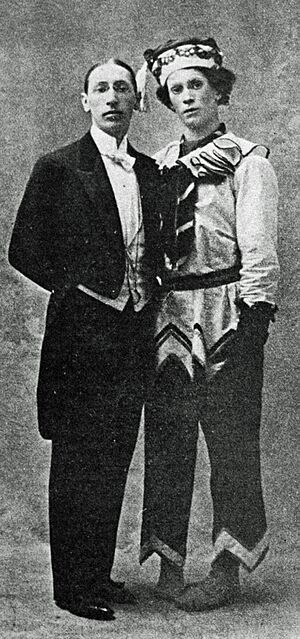
Petrushka was a big success. After this, Diaghilev made Monteux the main conductor for a European tour in 1911 and 1912. The tour went to London, Vienna, and Berlin. In Vienna, the famous Vienna Philharmonic orchestra struggled with Petrushka. They refused to play for Monteux at first. But Diaghilev stepped in. By the end of the rehearsal, Monteux was applauded.
In May 1912, Monteux conducted two more important ballets in Paris. These were Vaslav Nijinsky's Prélude à l'après-midi d'un faune by Debussy and Daphnis et Chloé by Ravel. Debussy himself was present. He told Monteux to play the music exactly as written.
The Premiere of The Rite of Spring
In 1913, Monteux conducted two more premieres for the Ballets Russes in Paris. One was Jeux by Debussy. The other was Stravinsky's The Rite of Spring. When Stravinsky first played The Rite of Spring for Monteux on the piano, Monteux was shocked. He thought it was a "horrible cacophony."
Despite his first reaction, Monteux worked closely with Stravinsky. He gave advice to help the composer. Monteux held seventeen rehearsals for the orchestra. This was a very large number. He wanted the orchestra to play the difficult music well. Monteux later said he didn't like The Rite then, and still didn't like it after conducting it fifty times. But he also told his wife that it hadn't "aged at all" after fifty years.
The first performance of The Rite of Spring caused a huge stir. People in the audience shouted, argued, and even fought. Monteux kept conducting the orchestra. Stravinsky later wrote that Monteux stood there "as nerveless as a crocodile." The event made Monteux, at 38, a truly famous conductor. Monteux believed that the audience's anger was mostly due to the unusual dancing, not the music. He later conducted a concert version of The Rite in Paris. Stravinsky called it "the most beautiful performance."
Conducting in America
During World War I, Monteux served in the French army. After two years, he was allowed to leave to conduct the Ballets Russes on a tour of North America. In 1916, he refused to conduct a ballet with German music. After the tour, he was offered a three-year contract at the Metropolitan Opera in New York. The French government allowed him to stay in the US.
At the Met, Monteux conducted famous French operas like Faust and Carmen. He worked with famous singers like Enrico Caruso. Critics praised his conducting. He also led the American premieres of some operas. Monteux enjoyed conducting opera, but he didn't like the atmosphere of opera houses. He felt that music was often less important than other things.
Leading the Boston Symphony Orchestra
In 1919, Monteux became the chief conductor of the Boston Symphony Orchestra. The orchestra was having a tough time. Many players had left. Monteux worked hard to rebuild the orchestra. He auditioned many musicians. By the end of his first season, the orchestra was strong again. Critics said he made the Boston Symphony "the most refined and musical in the world."
Monteux often introduced new music in Boston. He was proud of this. His contract was not renewed after 1924. The official reason was that the orchestra liked to change conductors every five years. Some people thought it was because the new conductor, Serge Koussevitzky, was more charismatic.
Amsterdam and Paris Orchestras
In 1924, Monteux began working with the Concertgebouw Orchestra in Amsterdam. He was a "first conductor" alongside Willem Mengelberg. They liked and respected each other. Monteux was very careful to follow the composer's score. Mengelberg was known for his own interpretations. Monteux conducted many concerts each season. He also led several operas in Amsterdam.
From 1929, Monteux also conducted the Orchestre Symphonique de Paris (OSP). This orchestra was founded with good funding. This allowed for many rehearsals and exciting programs. Monteux thought the OSP was one of the best orchestras he worked with. He conducted it until 1938. He premiered many new pieces, including Prokofiev's Third Symphony. The orchestra toured Europe and received great praise. Monteux liked it when audiences applauded between movements.
After 1931, the OSP faced money problems due to the Great Depression. Monteux started conducting classes in 1932 to help the musicians. From 1936, he held these classes at his summer home in France. This was the start of his famous conducting school.
San Francisco and the Monteux School
Monteux first conducted the San Francisco Symphony Orchestra (SFSO) in 1931. In 1935, at age 60, he was offered the chief conductor job. He was unsure because the orchestra had financial problems. Many players had left for Hollywood. But he accepted. The SFSO season was only five months long. This allowed him to keep working with the OSP. He also conducted the first concert of the NBC Symphony Orchestra in 1937.
Monteux's time in San Francisco greatly helped American music. He expanded his repertoire and deepened his understanding of music. He always included new music in his programs. He became an American citizen in 1942 during World War II.
Monteux wanted to help young conductors. He said, "Conducting is not enough. I must create something." He gave private lessons to many students. André Previn called him "the kindest, wisest man." Monteux's most famous teaching project was the Pierre Monteux School. It was for conductors and musicians. It was held every summer at his home in Hancock, Maine, starting in 1943. Many famous musicians studied there.
Monteux was a guest conductor with many orchestras. He never returned to the Boston Symphony while Serge Koussevitzky was in charge. But in 1951, the new conductor, Charles Munch, invited him back. Monteux also joined Munch on the orchestra's first European tour. A highlight was conducting The Rite of Spring in Paris with Stravinsky present.
Monteux left the SFSO in 1952. He believed conductors should not stay in one job for too long. He also wanted to conduct more as a guest. He returned to the Metropolitan Opera in 1953. He conducted Faust, which he had led at his debut in 1917. Critics highly praised his conducting. He conducted several other operas there. But he left when they refused his request to conduct an Italian opera.
London Engagements
Monteux loved London and British musicians. He conducted for the BBC and the Royal Philharmonic Society in the 1920s and 1930s. In 1932, he conducted the Hallé Orchestra in Manchester. The musicians were very impressed with his skill. In the 1950s, he made more appearances with London orchestras.
In June 1958, Monteux conducted three concerts with the London Symphony Orchestra (LSO). These were a huge success. He conducted Elgar's Enigma Variations. Audiences cheered him for several minutes. Monteux thought British concertgoers were "the most attentive."
The LSO offered him the main conductor job in 1961. He was 86. He accepted, joking that he wanted a 25-year contract. He conducted a wide range of music with the LSO. This included Mozart, Beethoven, Brahms, and Wagner. He also led a 50th-anniversary performance of The Rite of Spring with Stravinsky in the audience. Musicians felt he transformed the LSO. He made them feel like an international orchestra.
Last Years
Monteux remained energetic until the end of his life. But he had some collapses. In 1962, he fainted during a Beethoven concert. In 1963, he collapsed after receiving Britain's highest musical honor.
In April 1964, Monteux conducted his last concert in Milan. He was 89. He had plans to conduct at The Proms and for his 90th birthday. But in June 1964, he had several strokes. He passed away on July 1, 1964, at his home in Maine.
Personal Life and Legacy
Monteux had six children, two of whom were adopted. His son Jean-Paul became a jazz musician. His daughter Denise became a sculptress. His son Claude became a flautist. His adopted daughter Nancie later managed the Pierre Monteux School.
Monteux received many honors. He was a Commandeur of the Légion d'honneur, a high French award. He was also a Knight of the Order of Oranje-Nassau. He believed in fairness and was against racial discrimination. He hired black artists even when it was not common. He once joked that he was "colored – pink" when told he couldn't be served in a restaurant for black people.
Music Making Style
Reputation and Repertoire
Record producer John Culshaw said Monteux was "a conductor who was loved by his orchestras." Another conductor, Arturo Toscanini, said Monteux had the best baton technique he had ever seen. Monteux always insisted on the traditional orchestra seating. He believed it gave a better sound. He was also very strict about following the composer's score.
The New Grove Dictionary of Music and Musicians says Monteux was "never an ostentatious conductor." He prepared his orchestra carefully. He used small but clear movements to get beautiful sound and strong rhythm. He had an amazing understanding of music. He was very precise. Erik Smith, a record producer, said Monteux could change the Vienna Philharmonic's playing just with his gestures, even though he didn't speak German.
Monteux believed rehearsals were very important. He once refused to conduct a new ballet without rehearsal. He said, "Stravinsky, 'e can do what 'e like, but I have to do what ze composer 'as written." Some critics felt his style was too plain. But others praised him. Harold C. Schonberg called him "a conductor of international stature, a conductor admired and loved all over the world." When asked to describe himself, Monteux said, "Damned professional."
Monteux was often seen as a specialist in French music. But he loved German composers, especially Brahms, the most. He premiered many important works by composers like Stravinsky, Ravel, and Prokofiev. Stravinsky praised Monteux's "zeal and your probity in regard to the contemporary works."
Recordings
Monteux made many recordings throughout his career. His first recording was as a violist in 1903. His first recording as a conductor was of The Rite of Spring in 1929. Stravinsky was angry that Monteux made a rival recording.
Monteux's last studio recordings were in February 1964. He recorded works by over fifty composers. He preferred recording live concerts. He said he wished "one could record in one take in normal concert-hall conditions." Many of his live performances have been released on CD. These recordings show a passionate and disciplined conductor.
Many of Monteux's recordings are still available today. These include his recordings with the Boston Symphony, Chicago Symphony, Vienna Philharmonic, and London Symphony orchestras. He can also be heard rehearsing in some recordings. Video recordings of Monteux conducting are rare.
Images for kids
See also
 In Spanish: Pierre Monteux para niños
In Spanish: Pierre Monteux para niños


